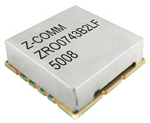 Modern digital communication systems using complex modulations such as Orthogonal Frequency Division Multiplexing (OFDM) or Quadrature Amplitude Modulation (QAM) require controlling bit error rate (BER) in order to achieve a given signal-to-noise ratio (SNR). The achievable BER is a function of many system parameters. Most important among them is the random phase fluctuations called phase jitter, which is a function of the phase noise contributed by the local oscillators in the transmit-receive path. Voltage-controlled oscillators (VCO), which serve as local oscillators in the transceiver of digital communication systems, play a very important role in meeting these goals by providing clean signals. The impact is even stronger in receivers as it leads to receiver desensitization by degrading the receiver’s ability to detect weak signals and therefore reduces the transmission distance of the communication system.
Modern digital communication systems using complex modulations such as Orthogonal Frequency Division Multiplexing (OFDM) or Quadrature Amplitude Modulation (QAM) require controlling bit error rate (BER) in order to achieve a given signal-to-noise ratio (SNR). The achievable BER is a function of many system parameters. Most important among them is the random phase fluctuations called phase jitter, which is a function of the phase noise contributed by the local oscillators in the transmit-receive path. Voltage-controlled oscillators (VCO), which serve as local oscillators in the transceiver of digital communication systems, play a very important role in meeting these goals by providing clean signals. The impact is even stronger in receivers as it leads to receiver desensitization by degrading the receiver’s ability to detect weak signals and therefore reduces the transmission distance of the communication system.
The VCO’s phase noise is affected by many factors, such as the shot noise of the active device, its flicker corner frequency, power gain, loaded Q factor of the resonating element, tuning sensitivity, tuning bandwidth, varactor equivalent noise resistance, frequency pulling, pushing, etc. Further, the overall performance of the VCO depends upon the variations in its parameters over extreme temperatures. It is therefore important to maintain superior performance over the operating temperature range. Besides phase noise, tuning linearity is also an important parameter in designing stable frequency sources. In addition, providing low frequency pulling and pushing is required as they contribute to the overall phase noise. All these factors put a heavy burden on the VCO designer.
The latest development from Z-Communications Inc. is a new series of coaxial resonator-based voltage-controlled oscillators called the ZRO series. These VCOs have been designed with innovative noise suppression techniques that allow for extremely low phase noise values and excellent bias stabilization. Also, the unique temperature compensation techniques used in its design enable excellent stability over temperature for phase noise, output power and tuning linearity.
To meet the demand of today’s digital communication systems and their strict phase noise requirements further lends to greater production strains on VCO manufacturers. Design margins for VCOs have needed to be greatly reduced in order to address these low noise specifications, but this comes with a price due to the impact it has on production yields, cost and the overall effect it can have on deliveries. However, the emergence of the ZRO series and its performance stabilization characteristics allows for the design of even tighter margins without compromising product throughput. This helps ease the concerns of those in the original equipment and contract manufacturing community who require quick turn deliveries of high performance VCOs to meet their tightening customer schedules.

Figure 1 Typical phase noise of the ZRO0743B2LF.
The first VCO of the ZRO series is the ZRO0743B2LF, which has typical phase noise performance of -131 dBc/Hz at 10 kHz offset and -151 dBc/Hz at 100 kHz offset in a frequency range between 738 and 748 MHz (see Figure 1). The ZRO0743B2LF also has very good tuning linearity over the tuning range from 0 to 6 V (see Figure 2) with a typical tuning sensitivity of 2 MHz/V. It also offers very good pushing (60 kHz) and pulling (300 kHz/V) performance thereby reducing their contribution to the overall phase noise.

Figure 2 Tuning characteristics of the ZRO0743B2LF.
Figure 3 shows the typical output power of the ZRO0743B2LF over its operating frequency and temperature range (-40° to +85°C). The typical output power delivered is 9 dBm. The built-in temperature compensation circuitry ensures linear output power over the extended temperature range. The harmonic rejection is better than -20 dBc over the operating frequency range.

Figure 3 Typical output power characteristics for the ZRO0743B2LF.
The ZRO series is available from 650 MHz to 4 GHz in narrow bands. For specific requirements or frequencies, customized VCOs are available. They come in two different package styles, the newly developed ZMX-14-SM package, which measures 0.75" x 0.75" x 0.22" and Z-COMM’s industry standard MINI-16 package, which measures 0.5" x 0.5" x 0.22". Both packages are surface-mount and manufactured to meet the European RoHS directive.
Z-Communications Inc.,
San Diego, CA (858) 621-2722, www.zcomm.com.
RS No. 302
